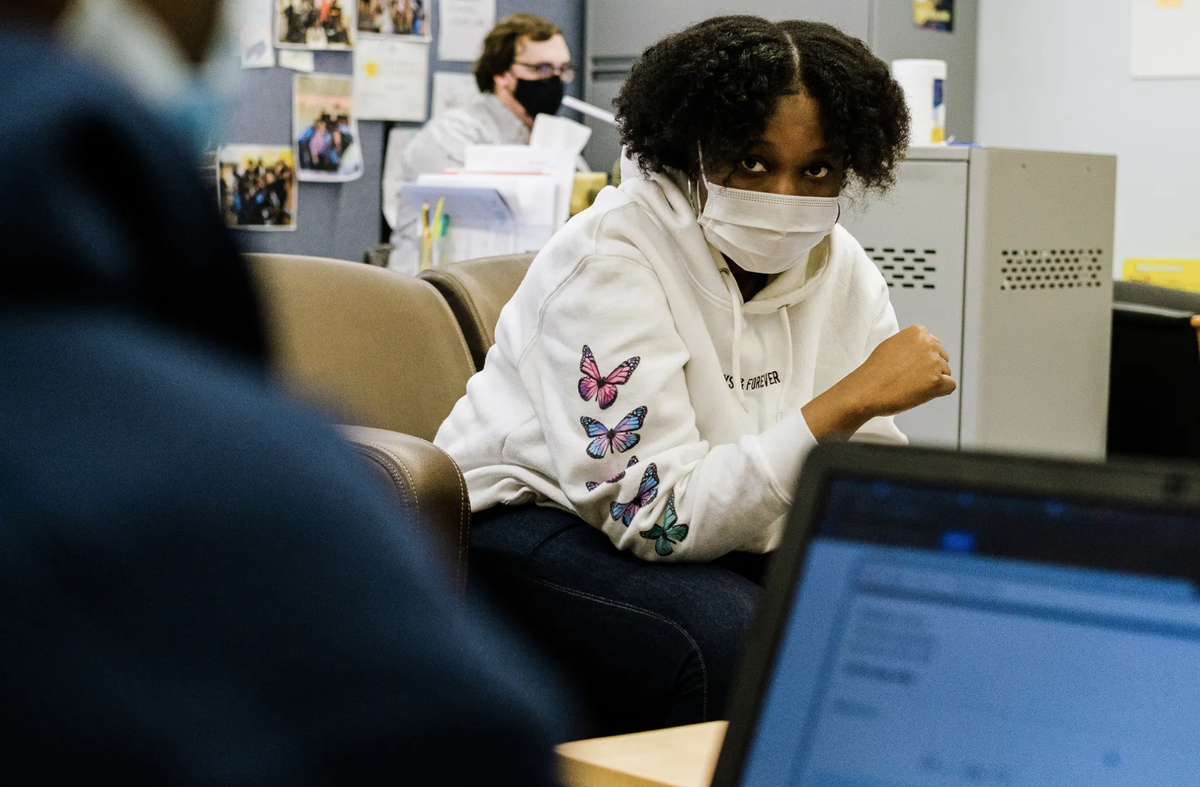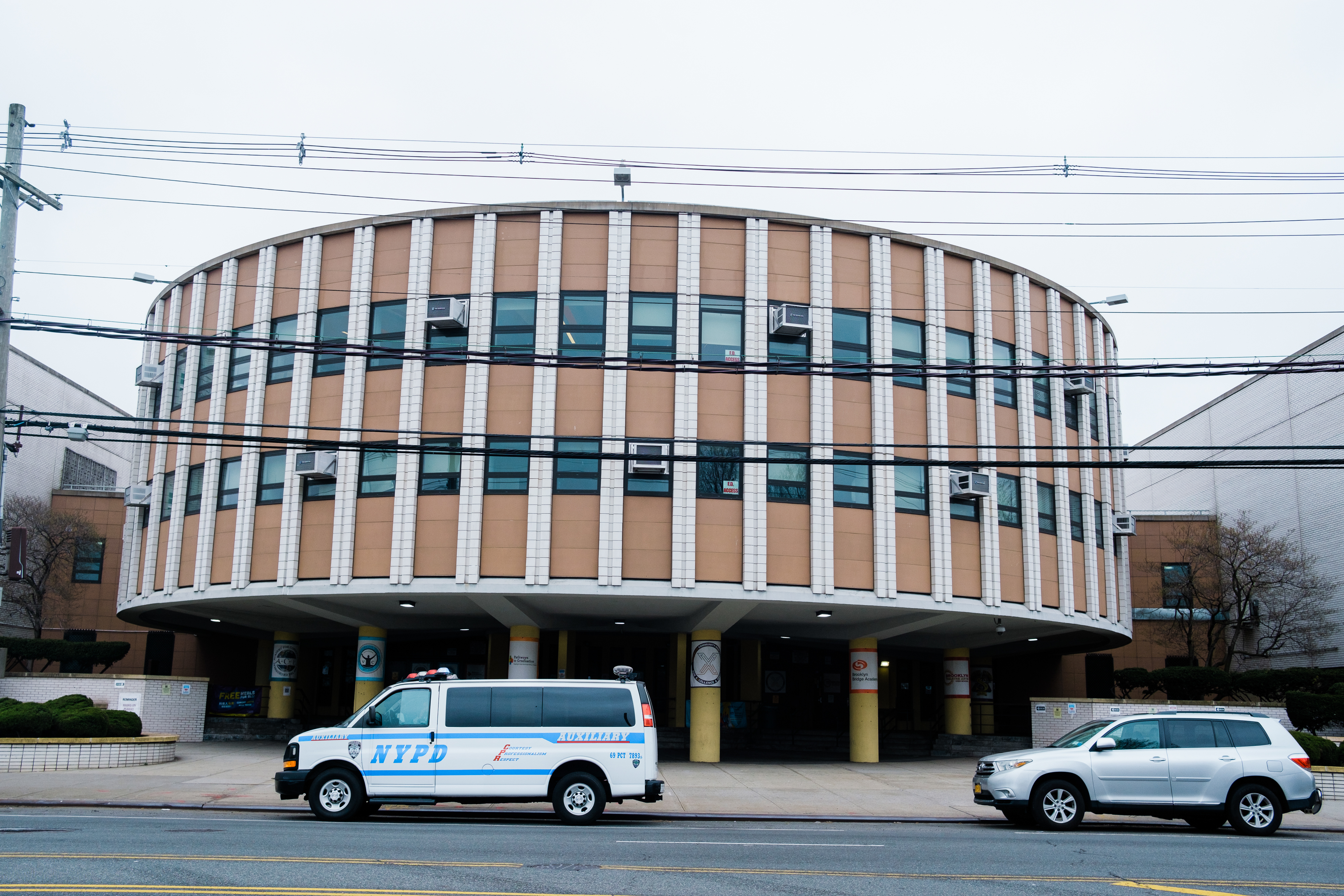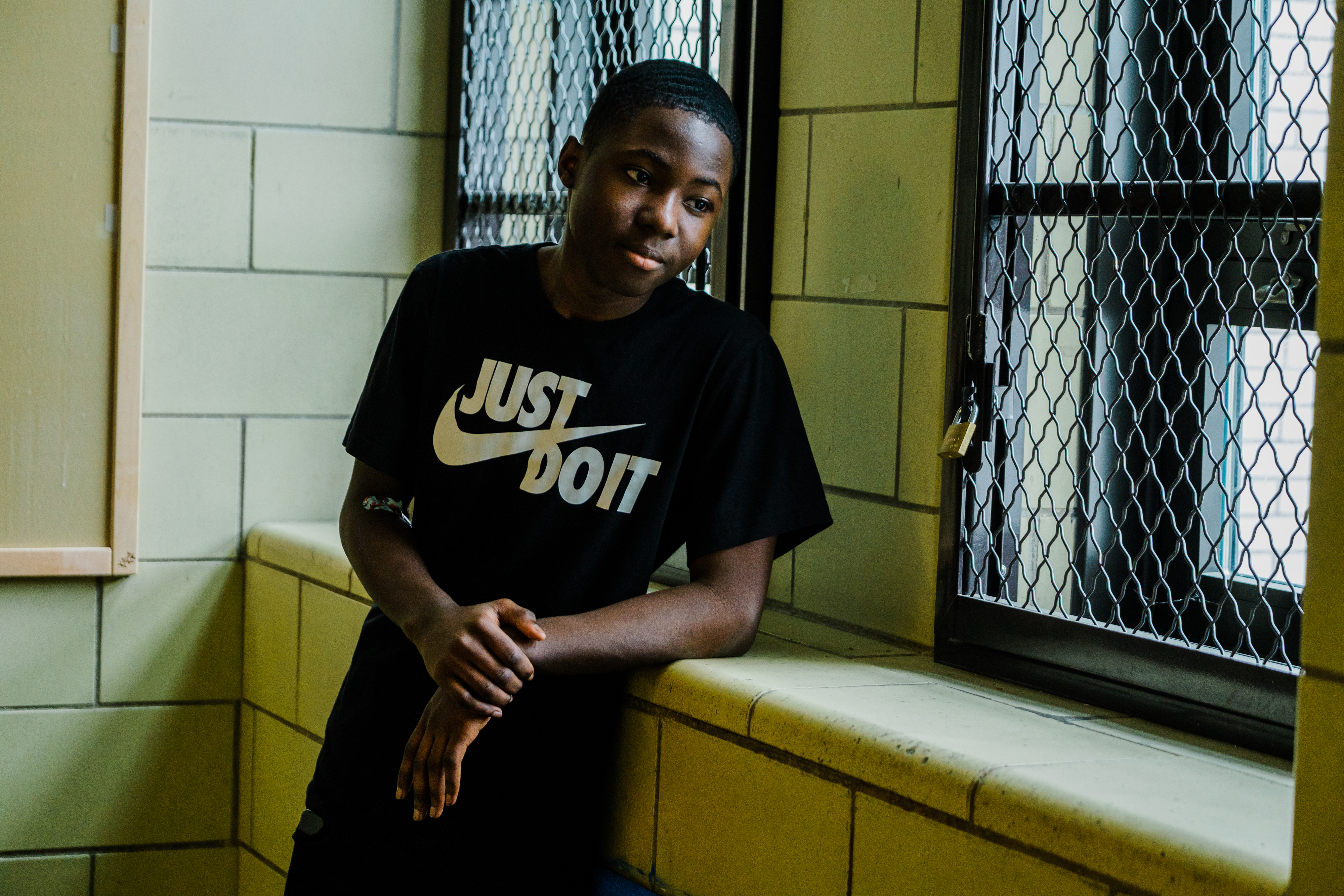COVID hit this Brooklyn high school hard. Paying students to tutor their peers is helping them get through it.

By Christina Veiga, Chalkbeat New York
Brooklyn high school freshman Alandinio Cineas was stumped: the algebra assignment asked him to write and graph an equation showing how many different pieces of fruit he could buy with $15.
As he worked from a quiet office at his school’s Canarsie campus on a recent afternoon, he shared the problem on his computer screen with senior Chahima Dieudonne. The students were in the same room, but divided by a cubicle and logged into a virtual meeting. With masks pulled over their noses, they were close enough to hear each other speak but kept their distance to limit their chances of spreading COVID-19.
Dieudonne read the problem a few times and thought out loud, in both English and Creole. Then she and Cineas spent the next hour figuring out his math homework together.
Dieudonne is one of roughly 15 students at Brooklyn Community High School for Excellence and Equity who is paid through a school internship program to provide one-on-one peer tutoring to students like Cineas who need extra help.
After more than a year of interrupted learning, many education experts are pinning their hopes on tutoring as an answer to some of the academic challenges students are facing. At this tiny Canarsie school, known as Brooklyn X, paying students to tutor their classmates has been a solution to a host of overlapping problems in a community reeling from the coronavirus.

The small-scale program has helped seniors fight off the fatigue of their last year in high school, much of which has been spent on screens. It’s provided a way for freshmen to forge social connections despite, for some of them, never stepping foot on campus. Crucially, it has put money in the pockets of tutors, some of whose families found themselves struggling to buy groceries as the virus raged.
The academic benefits are clear as well, especially in this school where many of the students are Haitian immigrants still learning English. Everyone who reached out for tutoring help last year, when schools first shut down, managed to stay on track to graduate, said Patrick Fernbach, who helps run the program.
That encouraging outcome “was definitely the highlight of remote schooling last year,” said Fernbach, the assistant community school director at Brooklyn X. He helps oversee the array of social services offered on campus through a partnership with the nonprofit Counseling in Schools.
‘Motivating the troops’
Wedged between a wide avenue and a vast public housing complex, Brooklyn X sits just beyond the last stop on the L subway line. Students come mostly from nearby Canarsie, while others take a bus from East New York, Flatbush, or Brownsville — neighborhoods in Brooklyn where a persistent lack of investment has weighed heavily on school performance.
A carousel of mayors and school turn-around programs have aimed to lift graduation rates and test scores at Brooklyn X and schools like it. Formerly known as Brooklyn Generation, the school changed its name last year in the latest attempt for a fresh start after graduating out of Mayor Bill de Blasio’s Renewal program, a school improvement effort that poured almost $800 million into social services like mental health supports and even washing machines so families could do laundry on campus.
With an enrollment of only about 200, attendance rates are higher than the rest of the city, and every family who answered surveys last year said their child was made to feel like they belong at the school. Still, at 72%, the graduation rate is about six points lower than the city average, and many students reported that they don’t feel safe in the hallways.

When COVID hit, it came hard at the neighborhoods that Brooklyn X serves. The ZIP code where the school is located is home to the largest number of frontline workers in the city, leaving them more exposed to the virus as they headed to jobs that could only be done in person. In neighboring East New York, the death rate is the highest in the five boroughs, according to city statistics going back to the start of the outbreak.
The same week that students began logging into remote learning for the first time last spring, Principal Louis Garcia came down with aches and a fever. Testing was scarce, but Garcia eventually learned he was in the first wave of New Yorkers to come down with the coronavirus.
With so much work to be done, and Zoom still a novelty, Garcia tried to lead a meeting with teachers when one interrupted him to ask why he was laying on the floor.
“I was just trying to find a comfortable position, and at some point I was just lying down on the carpet, not realizing I was on camera,” he said. “We didn’t know in the beginning to wear masks and do all those things while we were in the building.”
It quickly became apparent that Brooklyn X’s students would need help with more than just securing Wi-Fi hotspots and learning how to log into English class. Their families were short on food as the virus gripped their community.
The school is part of the city’s community schools program, which partners with nonprofits to provide social services and remove barriers that can get in the way of students trying to learn. At Brooklyn X, Counseling in Schools provides mental health support to students and families. Administrators and the Counseling in Schools team pivoted from their usual work and raced to open a food pantry. They also set out to track down students who had not connected online.
This year, the freshmen class was especially elusive: Many had never been on campus, meaning the school couldn’t tap into existing relationships or even, in some cases, up-to-date contact information. Staffers would eventually track down a few in homeless shelters; others had left the state entirely.
“You take for granted if you have a good address,” Garcia said. “If you have a kid in the building, you can say, ‘What’s your uncle’s number?’ or whatever.”
At the same time, Fernbach, the assistant community schools director, was grappling with what to do with the school’s paid internship program that had kicked off a few months before the pandemic. Placing students in jobs outside their homes was suddenly impossible, and among the most pressing problems was keeping students connected to their classes.
So the school decided to put students to work helping each other. If someone wouldn’t show up for virtual class with a teacher, maybe they would be willing to connect with a fellow teenager.
“They were in charge of motivating the troops,” Garcia said.
‘I wanted to help in return’
Dieudonne signed up to be a tutor because she wanted to help the same way her classmates had helped her when she came to Brooklyn from Haiti just days before starting ninth grade.

As a freshman, she often stayed late to get homework help from her teachers, rather than struggle alone at home and have to look up every word in a Creole dictionary. In class, whenever she got confused, her classmates jumped in with a translation or, if they didn’t speak her language, they explained the material again but using different words.
“If it wasn’t for the people who helped me, I wouldn’t be able to pass my classes when I first came because I didn’t speak English,” she said. “So I wanted to help in return.”
On a recent afternoon, she spent more than an hour working through algebra with Cineas. Dieudonne shot questions at him in English in a rapid clip. Cineas just looked at the screen. When she switched to Creole, something seemed to click. In a voice almost too small to hear, Cineas offered a response while typing in answers.
About 45 minutes into the assignment, they hit a roadblock, both confused by the online program Cineas used to graph an equation with X and Y variables. Dieudonne urged him to ask his teacher for a lesson on the platform the next time he was in class.
“I never used this,” she said. “I’m not used to being in algebra when it’s, like, paperless.”

Fernbach monitors sessions when students are first paired together, sometimes troubleshooting technology but leaving the material up to the students to tackle. He’ll check in afterwards to make sure the student who asked for help found the time useful, and that the tutor didn’t feel out of their depth.
He is thoughtful when pairing the peer tutors, trying to weigh academic needs along with personalities. When Cineas messaged asking for help with math, Fernbach knew he was a new student who could benefit from making more social connections. And while there may be students among his stable of tutors who are stronger with numbers, he knew that Dieudonne is approachable, well-liked, and dedicated to her studies — someone who also shares the same native languages of French and Creole.
The tutoring sessions have been valuable in giving recent immigrants more exposure to English even while they’re mostly at home, and therefore, with limited exposure to hearing and practicing their new language. He hopes that partnering students who have mastered English with their peers just learning it will serve as a point of inspiration and pride.
“I hope they learned that being bilingual is a skill,” he said. “I hope part of what they learned is they should treat it as an asset and it improves their value.”
‘My goal is to pass all my classes’
Dieudonne tutors between two to 10 hours a week, depending on her schedule and when other students need a session. She earns about $15 an hour, money she spends on the kinds of items many teenagers covet — clothes or a new pair of shoes. She joked she recently “broke” her bank account after buying a Swarovski crystal necklace as a birthday present for her mother, who is a home health aide, and cologne for her brother, who loads packages at a FedEx facility while working his way through college.
Other tutors help contribute to household bills. In some instances — often after a death in a family — students would ask for more work, Fernbach said,

“There were definitely students who, when things started to get really bad in May of last year, were saying, ‘I have more responsibilities with my family now so I could really use extra hours,’” he said. “We made as small a deal of it as possible, but just made sure they got the extra hours.”
Amid rising needs among students, Counseling in Schools has expanded its work at Brooklyn X, shifting money towards more mental health services and daily check-ins with students. In the background, however, the organization has contended with an uncertain budget. The city has yo-yoed between proposing major reductions, and restoring funding for nonprofits and other social services. To spread out the budget and invest in other crucial services, Counseling in Schools had to shrink the tutoring program from 25 students the previous year, to 15 this academic year.
“It’s not catastrophic to the program but it reduces the size of it and the scope,” Fernbach said.
The paid internships offer a valuable return on investment, Fernbach said. All of the students who participated last year passed their classes or graduated — an even more remarkable accomplishment considering that students who are learning English are among the most likely to fall behind. The citywide graduation rate for those students last year was below 46%.
The results click with a host of research that has proved that small group tutoring, when done well, is one of the few school interventions that really works. Researchers, universities, and think tanks have called for a national emphasis on tutoring to help students fill learning gaps ripped open by the pandemic. The massive federal stimulus package passed this spring has earmarked billions to help schools get students caught up, which means that tutoring programs could very well see a boost. The research, however, hasn’t looked at programs run by students’ own peers.
As the school year draws closer to ending, Fernbach said requests for tutoring sessions are only increasing.

Cineas admitted that online school was “not easy at all.” When high schools recently reopened, after a four month shutdown triggered by rising infection rates, his father pushed him to return to the building for in-person instruction, insisting it wasn’t good for his son to attend classes while lying in bed.
On only the third day back with students back on campus, Cineas was in Fernbach’s office. He logged on for a tutoring session. Dieudonne flashed on the screen.
“My goal is to pass all my classes,” Cineas said.
With Dieudonne’s help, maybe he will.
Chalkbeat is a nonprofit news site covering educational change in public schools.




